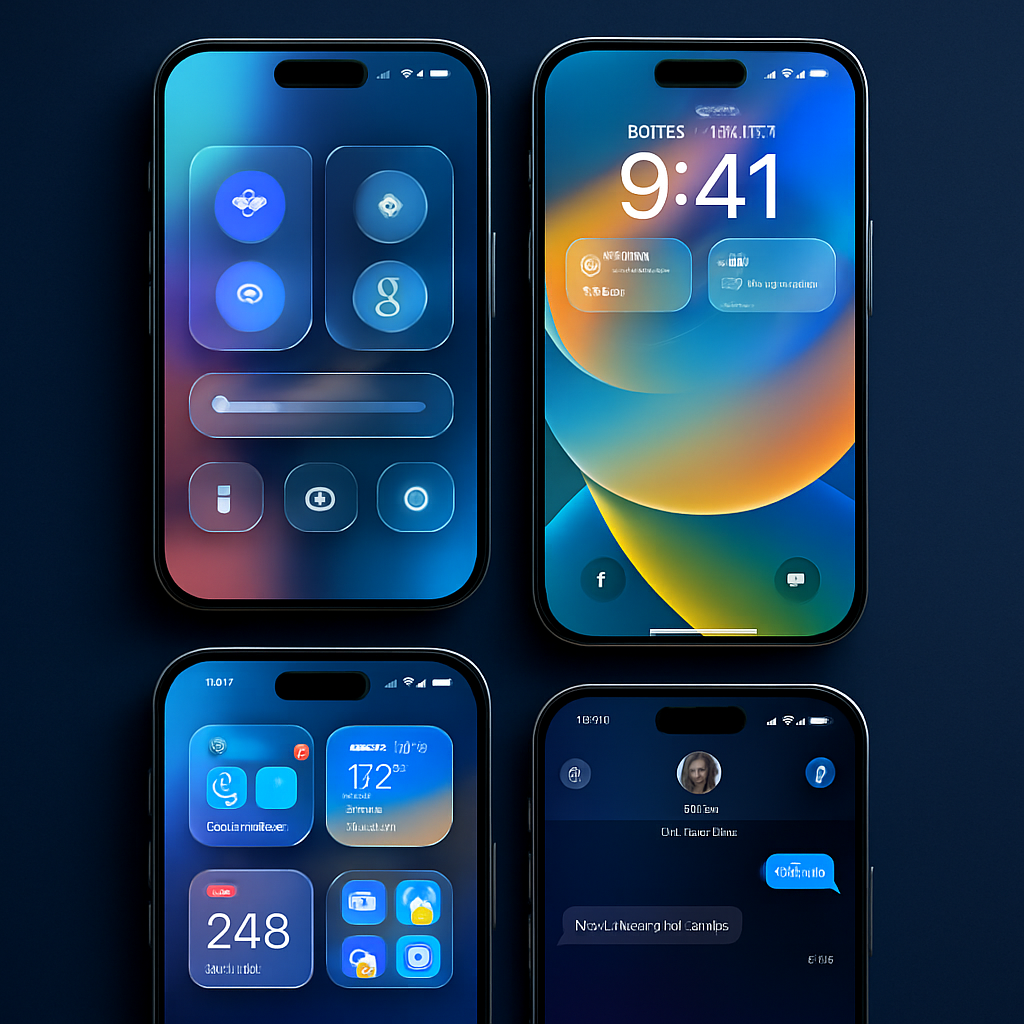
Apple has officially unveiled iOS 26, marking its most ambitious transformation of the iPhone experience in more than a decade. Introduced at the Worldwide Developers Conference (WWDC) 2025, this iteration signifies a departure from the traditional versioning system, aligning instead with the calendar year. iOS 26 is more than just a software update—it’s a shift in Apple’s design philosophy, technological integration, and user interactivity.
This latest version introduces a visually stunning redesign called Liquid Glass, a suite of AI features under the umbrella of Apple Intelligence, and robust enhancements across core apps such as Phone, Messages, Maps, Wallet, and CarPlay. The update promises to reshape not only how iPhones look and feel but how they assist, understand, and empower users in their everyday digital lives.
Liquid Glass: A New Era of iPhone Visuals
Liquid Glass is the cornerstone of iOS 26’s aesthetic transformation. This new interface theme draws from macOS’s design language, the iPhone X’s depth effects, and Apple’s recent spatial computing efforts. The result is a visually layered experience, filled with glass-like translucency, adaptive surfaces, and a fresh sense of motion.
The interface reacts subtly to movement and lighting. When a user tilts the phone or switches between light and dark mode, Liquid Glass elements reflect and refract the surrounding context, creating an immersive and elegant atmosphere. From Control Center to Home Screen widgets, the depth and blur effects make everything appear more organic and intuitive.
The new lock screen integrates time and notification banners into the wallpaper more fluidly. The Dock has a new gloss and hover effect, and Control Center has been rebuilt with customizable elements, dynamic behaviors, and an overall polished, reflective look. This system-wide redesign brings a renewed sense of identity and depth to the iPhone, making the interface feel both modern and tactile.
Apple Intelligence: Private, Powerful AI On-Device
The headline functionality of iOS 26 is Apple Intelligence, a new suite of AI-powered tools that runs directly on the iPhone. In contrast to cloud-based AI services from competitors, Apple has prioritized privacy and local processing, ensuring that the user’s data never leaves the device.
Apple Intelligence brings a wide variety of tools to iOS:
-
Live Translation: Calls, messages, and FaceTime conversations can now be translated in real time, allowing users to speak across language barriers with ease.
-
Visual Intelligence: The system can analyze screenshots, detect content like events, addresses, or objects, and offer contextual actions like creating calendar entries or doing web searches.
-
Generative Text and Images: With on-device generative models, users can compose more natural messages, generate unique images, or create emoji combinations using a feature called Genmoji.
-
Smart Suggestions: AI now powers deeper suggestions throughout apps like Mail, Notes, and Safari, adapting intelligently to user habits.
-
Shortcuts Automation: Apple’s Shortcuts app now includes AI-generated suggestions for automating tasks based on user behavior.
One of the most impressive aspects is that all of these AI capabilities operate locally. This ensures better privacy, faster response times, and reduced dependence on internet connectivity.
Revamped Phone and Messaging Experiences
The Phone app in iOS 26 has been redesigned for simplicity and power. Apple introduces a consolidated call screen that combines recent calls, voicemail, and contacts into one place. A new feature called Call Screening automatically detects spam or unwanted calls and can transcribe voicemails in real time. Another major addition is Hold Assist—a smart assistant that stays on hold during calls and alerts the user when a human is ready to speak.
Messages also receives a massive upgrade. Users can now set custom or AI-generated group chat backgrounds. A new polling feature allows group participants to vote on options directly within the thread. Typing indicators are expanded to group chats, and Apple Cash can be sent directly through messages, simplifying payments within social conversations. There’s also better spam detection and flagging for messages from unknown senders.
FaceTime, Photos, and Camera Improvements
FaceTime now includes built-in live translation, making cross-language video calls seamless. There’s also a focus on parental safety, with new tools that detect and blur explicit content in real time before it reaches young users.
Photos gain subtle but meaningful upgrades. The app includes a new Collections view for sorting memories by theme or date. Wallpaper creation is improved with a parallax-enabled 3D photo effect that brings depth and motion to the lock screen. The Camera app sees a streamlined UI with quicker access to resolution, aspect ratio, and mode switching.
The Debut of the Apple Games App
iOS 26 introduces a brand-new app simply called Apple Games. Designed to centralize all gaming activity, the app features downloaded games, Apple Arcade titles, achievements, updates, and friend leaderboards all in one place.
It also supports game replays, trailers, and a Game Chat feature that lets users coordinate in multiplayer sessions. With mobile gaming growing rapidly, this strategic move positions Apple as a more serious platform for gamers and developers alike.
Enhanced Maps, Music, Wallet, and CarPlay
In Apple Maps, iOS 26 brings “Visited Places,” a feature that lets users revisit past trips with a timeline view. Users can now set preferred routes for frequent commutes, and airport navigation has improved significantly with support for gate directions, lounge locations, and indoor mapping.
Apple Music gains AutoMix, which lets users blend tracks for continuous DJ-like playback. It also adds translated lyrics and a karaoke-style mic option using iPhone as a wireless microphone when paired with Apple TV.
Wallet sees major travel-focused enhancements. Users can store U.S. passport data, access boarding passes with improved gate change alerts, and even track luggage using Find My. Apple Pay now supports installment payments and cash-back reward tracking directly within the app.
CarPlay, too, receives upgrades including a minimized call interface, real-time messaging integration, support for pinned chats and widgets, and improvements to Live Activities. CarPlay Ultra takes this further, allowing Apple’s UI to span multiple screens in select car models, such as instrument clusters and heads-up displays.
Compatibility, Beta Timeline, and Release Window
iOS 26 is compatible with iPhones equipped with the A13 Bionic chip or newer. This includes models from iPhone 11 onwards. Older devices like the iPhone X, XS, XR, and iPhone 8 series are no longer supported.
AI-intensive features such as Apple Intelligence and real-time translation will be limited to newer devices with more advanced Neural Engines—starting with iPhone 15 Pro models and expected to be standard in the upcoming iPhone 17 lineup.
The developer beta is already available, with a public beta rollout planned for mid-July 2025. The general release of iOS 26 is expected to coincide with Apple’s annual September event, alongside new hardware launches.
Strategic Implications for Apple
The shift to a year-based naming system—iOS 26 instead of iOS 18—reflects a broader realignment of Apple’s platform cadence. By synchronizing iOS with macOS and other operating systems, Apple is simplifying its branding and emphasizing consistency across devices.
The unified Liquid Glass aesthetic not only offers a new visual language but also serves to reinforce the idea of a shared Apple experience across phones, tablets, laptops, watches, and spatial computing platforms like Vision Pro.
On the technology front, Apple Intelligence marks a defining moment in Apple’s approach to artificial intelligence. Instead of racing competitors in cloud-based AI, Apple has staked its reputation on privacy, security, and on-device processing. This creates a clear philosophical distinction and competitive advantage.
Final Thoughts
iOS 26 is more than a typical update. It’s a declaration of Apple’s future direction—visually refined, powered by private AI, and deeply integrated into the ecosystem. From the rich depth of Liquid Glass to the capabilities of Apple Intelligence, the update reshapes nearly every part of the iPhone experience.
With support for newer devices and forward-looking features, iOS 26 positions the iPhone not just as a smartphone, but as a personal assistant, creative partner, and intelligent navigator. As the public release nears, users can look forward to one of the most significant and intelligent iOS updates in Apple’s history.



